World Cup 2018: How Mexico stunned Germany by exposing their full-backs and harassing Toni Kroos out the game
Tactical analysis: After the tournament's biggest shock yet, Michael Cox breaks down how Mexico usurped the world champions
The first four days of World Cup 2018 have featured a string of impressive underdog performances, largely about sitting back and frustrating the opposition. Iceland’s defensive-minded approach worked well against Argentina , Switzerland were content to soak up pressure against Brazil , and both recorded unexpected draws. Mexico’s approach in yesterday’s 1-0 victory over reigning champions Germany , however, was braver, bolder and ultimately more successful.
Mexico manager Juan Carlos Osorio has been criticised for his constant chopping and changing, but while he might be reactive, that doesn’t mean he’s defensive. Here, he used a 4-2-3-1 system, rarely seen throughout Mexico’s qualifying campaign, in order to nullify Germany’s strengths and expose their weaknesses. There was plenty of attacking intent: Mexico pressed well in open play, and left three men upfront when defending set-pieces. In the latter stages they were forced to defend deep, but for long periods of the first half, they outplayed Germany.
Mexico’s key defensive tactic involved man-marking Toni Kroos, Germany’s deep-lying playmaker. Kroos was followed diligently by Carlos Vela, more renowned for his attacking speed than his defensive work, and occasionally by centre-forward Javier Hernandez, when Vela found himself out of position atfer attacking moves broke down.
Kroos failed to vary his position to find space, and without his metronomic influence, it was left to centre-back Jerome Boateng to spray hopeful diagonal balls into the final third, generally without success. Kroos only influenced the game when Mexican man-marking was impossible - his 25-yard free-kick was expertly turned over the bar by Guillermo Ochoa.
Whereas Kroos was tracked everywhere, Germany left-back Marvin Plattenhardt was completely ignored, with Mexico’s right-sided midfielder Miguel Layun tucking inside to assist the outstanding duo of Andreas Guardado and Hector Herrera, frequently leaving Plattenhardt all alone.
Germany seldom looked towards him, however, and this felt somewhat similar to Germany’s experience at the last World Cup, when Benedikt Howedes, naturally a right-sided centre-back, offered no threat from left-back, which allowed the opposition to mark more dangerous players. Four years on, the left-back problem hasn’t been solved.
But the real battleground was on the opposite flank, where Germany’s Joshua Kimmich played an absurdly attack-minded role: overlapping Thomas Muller regularly, and sometimes making diagonal runs into centre-forward positions. He offered an attacking threat in the first half, crossing to the far post and nearly tempting Mexico right-back Carlos Salcedo into an own goal, and later chipping into the path of Timo Werner, who tested Ochoa after a quick turn. He also attempted an extravagant bicycle kick from on the penalty spot, hardly the natural positioning of a right-back.
Kimmich’s attack-minded tendencies constantly caused Germany serious problems when they lost possession, because Mexico’s dangerman Herving Lozano, playing on the left, remained in a position to counter-attack and regularly found space on the outside of Boateng.
This was apparent inside the first two minutes after Vela and Hernandez had found space between the lines, and on 17 minutes Hernandez drifted to the left himself, before producing an unsuccessful pirouette in an attempt to work the ball onto his right foot, when he might have pulled the trigger with his left.

Lozano was the greater threat, however, and Mexico ought to have located his dangerous runs more regularly, with better decisions on the counter-attack. Boateng and Mats Hummels were badly exposed against several Mexican runners, with huge amounts of space in the full-back areas, vacated by the dangerous Kimmich and the ineffective Plattenhardt.
Hernandez, meanwhile, also made runs towards play, bringing Boateng or Hummels up the pitch, and opening up space for others to exploit. Generally considered a mere goal-poacher at club level, Hernandez’s all-round game for Mexico has always been impressive, and here his movement in deeper positions was outstanding.
Mexico’s winner, on 35 minutes, was a perfect demonstration of their attacking strengths.
Germany lost possession in midfield with Kimmich charging forward on the overlap, leaving Lozano with space to break into.
Hector Moreno’s direct pass into Hernandez, again moving deep, prompted such a neat one-two with Guardado that it left Hummels on the floor, which in turn meant Boateng was isolated against both Hernandez and the rampaging Lozano.
Mesut Ozil, of all people, found himself desperately attempting to cover Kimmich’s right-back zone, but Hernandez slipped in Lozano, who turned inside and crashed home the biggest goal of World Cup 2018 so far.
Join our commenting forum
Join thought-provoking conversations, follow other Independent readers and see their replies
Comments